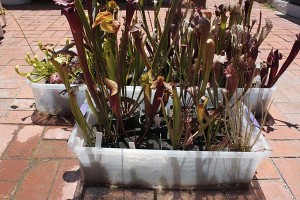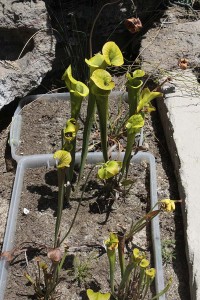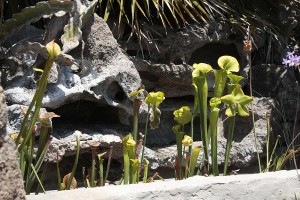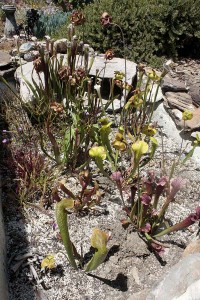Arleen of Camissiona’s Corner asked about how I made the little bogs where I’ve got various swamp and other moisture-loving plants. Here’s a quick rundown of the three different methods I use to keep these plants happy.
The most straightforward is the classic water-tray method. You basically take your potted plants and stand them in a tray of water. It keeps the pot moist-to-wet as long as you have water in the tray. I like to let the tray dry out for a day or two so mosquitoes don’t start breeding in the water.
My method number two is to grow plants without pots in undrained tubs. Here I’ve buried the tubs in dirt at the level of the tub to distract from the ugly container. Since I’m primarily growing sarracenia, American pitcher plants which detest rich soil, the mix I’ve used here is a low-nutrition combination of one part clean sand to one part peatmoss.
Here you see the plants from the side. The ugly tub practically disappears.
This technique has the disadvantage in that the bottom of the tub can develop anaerobic conditions as the water sits. I’ve heard of some growers installing watering tubes that deliver new water to the bottom of the planter. This lets fresh, oxygenated water occupy the place of the old, stale stuff. Other growers don’t bother with it. This is my first year with this system, so I can’t comment on how well it does.
The third method I use is similar to the last in that it uses a basically impervious container this time with some drainage. In this case, I converted a shallow concrete fishpond that was the constant target of neighborhood critters. I drilled several drainage holes in the bottom and attached little plastic “snorkels,” short lengths of tubing that fit into the drainage openings and extend up to near the top of the soil line. In theory this keeps the bog from turning into a submerged swamp in the wettest weather, though so far we’ve never received that much rain at once in the three seasons I’ve had this bog. The fit around the little snorkels isn’t perfect, so over time all water will leak out the bottom anyway, keeping this setup from going anaerobic like the method above.
I’d guess that you could accomplish the same result by drilling a few tiny holes in the bottom of the tubs like I’ve used in the second setup. Or you could use a commericially available plastic pond insert. I didn’t do that in my second method because that was yet another failed pond. In this case plant roots invaded the pond and caused it to leak. I didn’t want to encourage the roots again by supplying them with more water.
I’ve never tried growing vernal pool plants in these bog setups, but I think method one and three might be good ways to make it happen. Unlike these bogs you’d want to let the vernal pools go dry during the summer and fall. Choice of soil mix would be another difference to consider. Vernal pools around here form in the thick clay that caps our mesas around town, so the plants would probably want more nutrition that classic bog plants would prefer. Watering with something other than Southern-California water out of the tap would probably be a good idea too unless you’d want the pools to turn into alkali swamps. If you have experience with constructing a synthetic vernal pool, I’d love to hear from you to see if my guesses are close to the mark!





James, that was really informative, and thanks so much for responding to my comments/questions with such detail. I’m actually inspired now to try my own bog garden. The scale is doable and the materials are easily obtainable. With your suggested methodologies, I think I will also be able to craft an experimental vernal pool before our fall-winter rains commence. The idea is to let the rains do the watering (versus tap), and then allow the synthetic pool to evaporate on its own (takes care of the anaerobic & potential mosquito breeding issues). Our soil here is primarily DG, but we’ve also got some clay. Probably some affinity to the soils found in the nearby Santa Rosa Plateau.
Interesting. Some day I want to try to grow some pitcher plants. I’ve grown plants in ponds a few times and we have a below-grade bathtub that sounds a bit like your drilled concrete pond, though ours just has the drain open with no snorkel holes. Stream orchid, scarlet monkey, canna, and black magic calocasia are growing in it. We had meadow foam and yerba buena when the planting was new, but they’re shaded out now.
Neat! Any opinions on using coconut fiber instead of peat moss?
Arleen, I’ll look forward to seeing how well you do with your vernal pool. It sounds like you’ll be trying to do it as naturally as possible, and I think you’ll stand a good chance of success. I know that Barbara over at Weeding Wild Suburbia has mentioned that Rancho Santa Ana Botanical Garden in Clairemont has a vernal pool exhibit, but I don’t know how they’ve made it happen.
Ryan, that’s a great use for an old tub. I’m still trying to find the ideal place for the stream orchid, though it’s happier in the bog than it was sitting with its toes in the fishpond. I should try the wet monkeys for some variety.
Christine, I haven’t used coconut fiber. I use sustainably harvested peat, but I know that using no peat at all would be a better option. From some quick researches on coconut fiber issues with carnivorous plants it sounds like the material often comes with high levels of salts which are deadly to the carnivores. One posting I saw said to use coconut fiber for carnivorous plants only if it advertised that it had been left outdoors in the tropical rains for three years. But I know Europe has been working hard to get green by reducing its dependence on peatmoss.
Very interesting. I’ve never done a bog garden although I suspect they will become more popular as more landscapes include dissipation channels and other means to keep water on site. The closest I came was when I presented a concept plan to the client and said “here’s where the bog garden will go.” They looked at me blankly. Apparently I’d misread my own notes and read dog as bog – they wanted a space set aside for Fido to do his business.
fascinating! You are definitely determined! Thanks for all the great photos. It really helps to understand how to create these bogs. The idea of inserting “snorkels” is really interesting.
Those are gorgeous! I just planted some of my own in a fountain… three tiers of carnivorous plants.
What a great idea – a few weeks ago I was walking around a bog that is a bit north of me, and I was thinking about how fun it’d be to have a little bog of my own. And now I come across this! Thank you.
drill the holes 6-10″ from the top so there roots are in the water but the bulb isnt but everything should be moist and LOTS of sun andNO FERTALIZER i use 50gal drums bottoms about a foot deep with hole 4-6″ from the bottom then bury it to the top they look just like part of the scape half peat half FL sand full sun all year in cen. FL